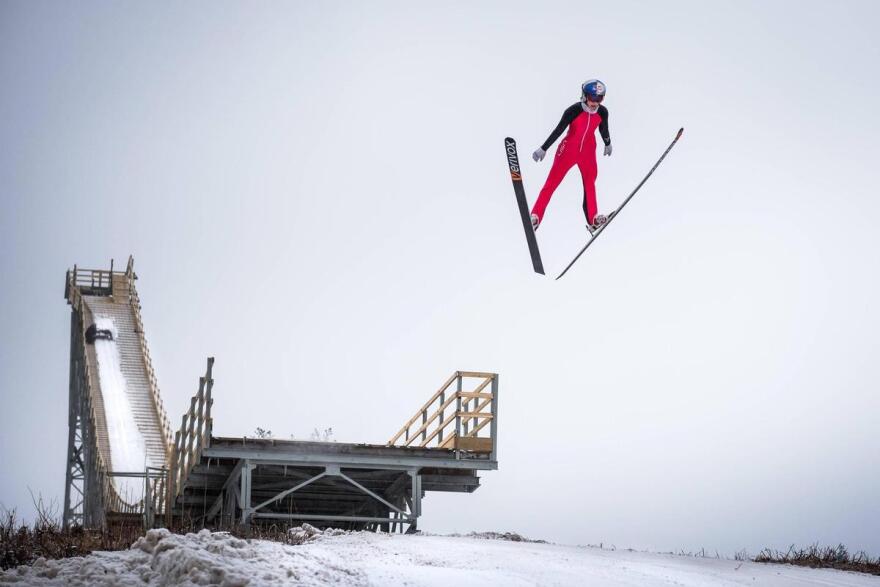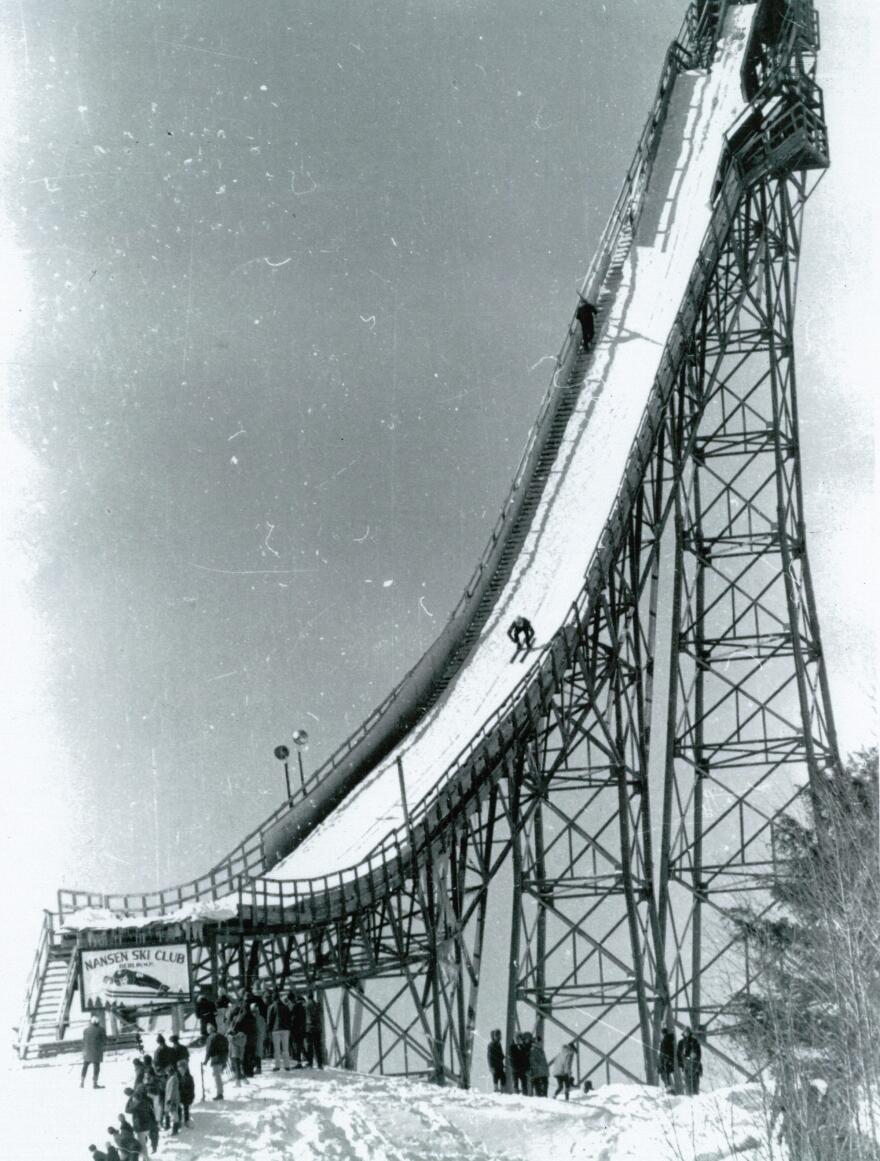The dream of waking "the sleeping giant."
This audio postcard is part of Word of Mouth's series on the North Country.
Listen to the North Country
"Where Does the North Country Begin, and End, in N.H.?"
"Mill Complex": Is the North Country ready, willing, and able to shift from a timber-based economy to a tourism-based economy?
"Side-by-Side": Is the North Country moving towards an ATV-based economy? And if it is, what does this mean for residents who aren't sold on the idea?
The Sleeping Giant
The Nansen Ski Jump is technically in the town of Milan, but you get there by driving through Berlin. When I visited in May, Peter Higbee showed me around. Higbee is a city council member and the president of the Nansen Ski Club, which mostly focuses on cross country skiing. We hiked up to the launching-off point of the ski jump-- the bottom of the actual jump and above the landing hill.
"Up here you get the feeling of what it must be like to go off that jump and be so high," said Higbee as we climbed the hill. "And you also get a sense of the incredible steepness of the hill you're aiming to land on... I keep looking to see when we get our first view of the big Nansen."
The Nansen Ski Jump had sat unused for 30 years until 2017, when a professional ski jumper, Sarah Hendrickson, sailed off it for a Red Bull commercial -- but no one has gone off it since.
When we got to the jump, we walked straight to the top of the landing hill and looked down. It was so steep.
"That’s why I love coming up here... is that amazing or what?!" exclaimed Higbee.

When you’re standing at the top of the jump looking out at this expansive valley, it looks like the ski jumpers could go on forever. The landing hill seems like it leads directly to the road.
Higbee says the physics of the jump work out so that doesn’t happen, but even so, the jump will need some modifications to be used for future competitions.
"So this is the landing hill and it is an incredibly steep hill, steeper than it will have to ultimately be. We're going to have to do some dirt moving and change the shape of the landing hill before we can have sanctioned competitions here," said Higbee.
When it was built in 1936, the Nansen Ski Jump was the largest jump of its kind, 171 feet high, made of steel, and reminiscent of the top of a roller coaster.
"This was, for the longest time, the tallest ski jump in the country," said Higbee."And the 19-- hope get my dates right!-- '38 and '39 Olympic trials were held here, and they came from all around to jump off the big Nansen."

The ski jump hasn’t been used in competition since the 1980s, but there is an effort now to hold competitions there and to rebuild a youth ski jumping program in Berlin. The goal of the Friends of Nansen Ski Club is to hold some kind of ski jumping event there by February 2020.
"Well maybe we can we can bring back... that they called it the sleeping giant. Bringing the sleeping giant back to life again," said Higbee.
The original Nansen Ski Club was organized around the Winter Carnival in Berlin, which was put on, Higbee says, by immigrants from Scandinavia who had come to work on the railroad.
"We have old pictures, if you stopped by the Historic Society, for instance, you can see pictures of people doing snowshoe races with obstacles. They're jumping over big barrels with snowshoes on," said Higbee. "Do you know what skijoring is? Where you're on cross-country skis and you have a tether to a dog and the dog kind of pulls you around... you're skiing, too, but the dog also pulls you. They used to do that with horses down near where I live now."
Even before the ski jump was built, the Scandinavians knew how to make the most of winter. But in the early 1930s, Alf Halvorson had an idea -- well, he had a lot of ideas, but one of them was to build a ski jump near Berlin. With the help of some organizations, he made it happen. Alf was a nordic skier, a ski jumper, and an Olympic ski coach.
His grandson, Scott Halvorson, is now a large part of the effort to make the ski jump usable again. While Scott was never a ski jumper himself, he remembers the events there clearly.

"It was a very, very exciting time. People came from everywhere. Berlin was the place to go. There was the winter carnival, there was various activities throughout the downtown... the downtown was virtually closed down. Back then Berlin had hotels. The hotels were full. They had the Carnival Ball," said Halvorson.
Back during the 1938 Olympic trials, 25,000 spectators showed up to watch ski jumpers go off the Nansen. Old pictures show the fields below filled with cars. The gas stations in Berlin even ran out of gas.
The Nansen held its last competition in 1985. It stopped for a number of reasons, but, most notably, the volunteers who had been making these event happen were getting older, and professional ski jumpers were going elsewhere to use more modern jumps.
That’s part of why the big Red Bull-sponsored jump with Sarah Hendrickson in 2017 was a big deal.
Opinions about the Red Bull stunt are varied. On the one hand, it wasn’t open to the public. It was a private event, and that made some people upset because it’s something they would have liked to witness. But those in attendance, said Scott Halvorson, thought it was pretty amazing.
"It's kind of strange that I get emotional about it but it was like you thought something was dead and gone that was very important. And all of a sudden there it is," said Halvorson. "It was a freezing cold, cold morning. It was early and there wasn't one person there that was complaining about it. It was an absolutely magical moment to show that that jump came to life. And it was virtually impossible to leave there without wanting more."
A few years before Hendrickson's jump, the state had started clearing up the area around the Nansen Ski Jump. They installed a historical marker near the base. But Scott told me that the Red Bull commercial made the goal for the Nansen more ambitious.
"It's kind of evolved. You know it started with, 'geez, the jump is all grown-in, you can't even see it.' And I'd drive up there and I would be heartbroken. I didn't do anything about it but I was heartbroken about it. It was gone. You couldn't see it from the road, believe it or not," said Halvorson.
Halvorson and others think that the ski jump could help bring visitors to Berlin in the wintertime, and that would be good for the local economy. They also want to bring back the spirit and tradition of Nordic sports, and they want local kids to enjoy it, too.
The Friends of the Nansen ski jump is actively fundraising to renovate parts of the ski jump: they need to flatten the landing slope, which Higbee mentioned, and to install new side guards for the deck and the landing hill. The total price tag would be almost $400,000, but they hope that they can begin construction in late summer or fall to have the jump ready for action by February 2020.
"I love the ski jump for various reasons: just because it's an incredible incredible icon of the North Country, my family connection... but more than that I really want to see Berlin be revitalized," said Higbee. "This project is not just about, you know, 'hey, we're going to get the big ski jump going again, we're gonna get some really good ski jumpers up there, we're gonna hold an event there once a year...' We want to bring ski jumping back to the North Country."







